Dr Vino's wine blog
wine talk that goes down easy
The best white wine under $15
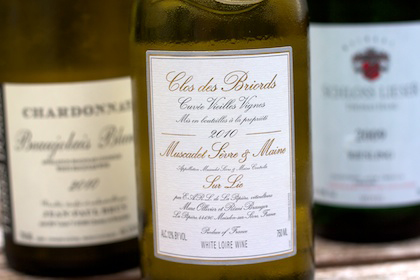
What’s the best white wine currently in the US market for about $15? I’ll make a case for the 2010 Clos des Briords from Marc Ollivier (Domaine de la Pépière).
The 2010 is electric. After the 2009 had more ripeness, I find 2010 a reversion to the exciting norm of citrusy freshness and minerally, iodiney verve. Pairing it with seafood, particularly shellfish, is probably about as much fun as you can have with a $15 white wine. (search for this wine at retail) The wine comes from a single vineyard in Muscadet, one of vines planted in the 1930s. The wine stays on its lees up until bottling, which also helps account for more depth than your average Muscadet. It’s also particularly age-worthy, and I’m scouting out some magnums to tuck away. Emphasizing the minerailty over fruitiness means this wine isn’t for everyone. But for those who love wines so taut you could play a DVD on them, check out what is the best white value out there.
A runner-up would certainly be the Terres Dorées Beaujolais Blanc, a Chardonnay, also from 2010 (above, left). The wine is a perennial better value, but the 2010 exhibits a value chardonnay in its minerally, unadorned form that is stunning. (On a related note, I was a huge fan of the 2009 red Terres Dorees, but didn’t find the 2010 red to have the same snap.)
Which wine would you nominate as the best white wine around $15 in the market today?
The best bottles are the quickest emptied: Mugnier edition
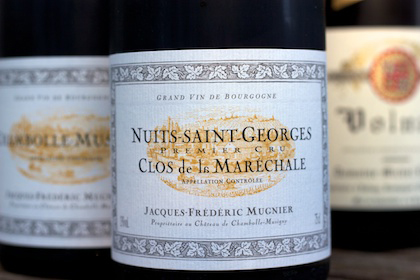
The best bottles are the quickest emptied. But you knew that.
Last week, I made my wife a birthday dinner. But before I started covering the kitchen counter and, inadvertently, the floor and my clothes with flour to make fresh pasta, I popped open a bottle of slightly chilled Mugnier Clos de la Marechale 2007. By the time we got to the table, I was dismayed to find most of the wine had evaporated!
The 2007 Clos de la Marechale is drinking very well now. I had the good fortune of tasting the 08 and the 09 this week too at a trade tasting. While the 07 is the least heralded of these vintages, it is certainly not one to overlook with delicious balance of fruit, acidity and tannin. The ’08 has more red berry notes, acidity, tannin, balance and gorgeous oomph that bodes well for a long cellar life. The ’09 has more dark fruit character, slightly more ripeness and roundness and elegant concentration, with a spice note that culminates an a faint whiff of pepper. All bear the signature of Frédérique Mugnier for the “bargain” price of under $100. (Find these wines)
Peter Wasserman, who works to export the wines, told me that “Freddy” Mugnier, the winemaker and a former petrochemical engineer, has undertaken a geological survey of the vineyard this year. While the wine making remains very hands-off, for the first time, he will be harvesting the grapes from similar soils and making the wines by those parcels instead of by vine age (45 – 70 years old). All the vats will still be blended in to the 2011 Clos de la Marechale.
Wine labor in South Africa
I’m a day late to the theme of the Labor Day holiday. But, heck, why don’t we make it Labor Week? In the wine world, the efforts of those who prune, spray, and harvest go mostly unheralded as we tend to focus on glamorous vintners or winemakers. Perhaps nowhere is the labor situation as acute as South Africa.
There, wine farms, as they are known, have been around for centuries, making South Africa possibly the oldest “New World” wine countries. Sadly, the “dop” system, now illegal, of paying workers a portion of their pay in wine also spanned centuries, bringing with it devastating health consequences for the farm workers. A recent report from Human Rights Watch contends that the industry still has a long way to go for meeting a suitable minimum standard for worker conditions.
Still, there are signs that the industry in the racially divided country is changing. The NYT recently ran a terrific profile of Ntsiki Biyela, originally from KwaZulu Natal who had never tasted wine before learning to make it on a scholarship at Stellenbosch University. Now she is the wine maker at Stellakaya Winery and was hailed as the country’s Woman Winemaker of the Year in 2009.
Mark Solms, a psychoanalyst, left South Africa during Apartheid. When he came back to later take control of the family farm, he did so by mortgaging his own property so that the black workers could become one-third owners in the adjoining property and set up a museum trace the history of workers on the farm. He talks about it in the below video at a TED conference in London. “The answers are obvious–it’s not brain science. You only really have to want to.”
Stealth box wine РMagdala ros̩
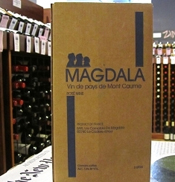 As a fan of the box wine format, though not always the wine inside, I was pleased to see Eric Asimov and the NYT wine panel recommend some box wines. Their clear favorites were the Wineberry Cotes de Rhone red and the Estézargues , boxes that I have also recommended.
As a fan of the box wine format, though not always the wine inside, I was pleased to see Eric Asimov and the NYT wine panel recommend some box wines. Their clear favorites were the Wineberry Cotes de Rhone red and the Estézargues , boxes that I have also recommended.
One they may not have included in the article was the Magdala rosé. We’ve worked our way through a box of the 2010–liquid air conditioning–so far this summer at the Dr. Vino World Headquarters. It’s from importer Jenny & Francois and is a darker rosé in the glass that hails from organic grenache and cinsault vineyards in Provence. Solid rosé, especially for the equivalent of $7.50 a bottle. (Find this wine at retail.)
I was talking about this wine with a friend recently and he told me that he loves the Magadala rosé for its stealthy refreshment. Every year, he pops the bag of wine out of the cardboard box and puts it at the bottom of a large canvas tote bag, covering it in ice packs, towels and sunscreen. Then he proceeds to a tennis tournament that may or may not rhyme with US Ropen and drinks the rosé all day instead of whatever overpriced swill is at the concession stand.
Beaulieu Vineyard, Georges de Latour, 1958
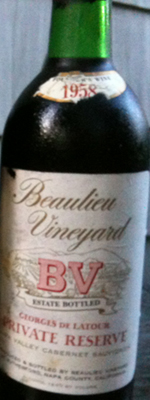 I always relish the rare opportunity to taste a California wine from the 1970s, the era before rising temperatures and fruit bombs. But I recently had something even more rare: tasting the BV, Georges de Latour, Private Reserve, Napa Valley, Cabernet Sauvignon, 1958.
I always relish the rare opportunity to taste a California wine from the 1970s, the era before rising temperatures and fruit bombs. But I recently had something even more rare: tasting the BV, Georges de Latour, Private Reserve, Napa Valley, Cabernet Sauvignon, 1958.
The wine was made by the venerable Andre Tchelistcheff, the “dean” of California winemakers of his day. Georges de Latour, a Frenchman, bought Beaulieu in 1899 and apparently made a fortune selling sacramental wine during Prohibition (people were so devout during Prohibition!). With the end of the Prohibition profits, de Latour decided to embark on the quality route and went to France to find the best Frenchman for the job. But in 1938, he returned with Andre Tchelistcheff, a Russian refugee as winemaker. The Private Reserve slightly preceded Tchelistcheff’s arrival (the first vintage was 1936), but it as the flagship for the estate, it was his signature wine for much of his career. In 1969, Beaulieu sold to Heublein; now it is owned by Diageo.
The 1958, a legendary wine, was showing gloriously at a recent tasting at a collector’s house. Easily one of the best California wines I have ever tasted, the gorgeous mature cabernet from start to finish was spectacular: the wine was still structured and very much alive. Some dark fruit remained but there was also a a dose savory, earthy notes. More than anything, it was the texture of the wine and the finish that just wouldn’t quit that really set it apart and made it so downright drinkable, enjoyable, and worth savoring every drop. It was so outrageously good that even showed better than the 1971 JJ Prum that was at the same tasting–and this was according to one of Riesling’s most ardent fans was was also at the tasting.
Incidentally, I checked out the back label and was amused Read more…
J.J. Prum, Wehlener Sonnenuhr, 1971
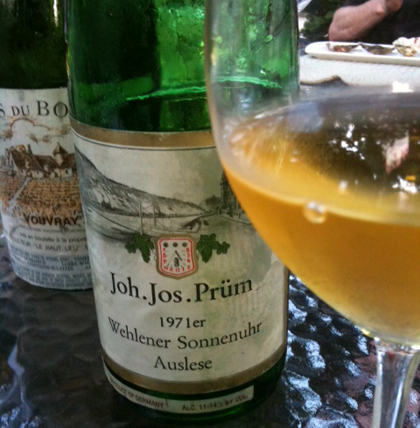
With the year almost half over (um, where did it go?), I thought it about time to post about a few memorable wines that I’ve tasted so far this year.
First among these needs to be the J.J. Prum, Wehlener Sonnenuhr, Auslese, 1971. In the vernacular of the day, the wine is epic, though not an #ecpicfail mind you but an epic success. Forty years young, I’ve had the good fortune of tasting the wine twice this year. The first was in Vegas celebrating a high school friend’s fortieth birthday party. I saw it on the list at Lotus of Siam and had to buy it for him. Although he’s not that into wine (it does happen from time to time but he’s still a great guy), he loved the wine as did the others in our group who don’t even usually drink white wine. It was really fun to reach back in time the way wine can so joyously. My buddy tells me he keeps the empty bottle on his desk.
I had the wine again recently (actually, it was the “gold capsule” bottling this time) with a small tasting group and it was singing. The wine is a golden color with a deliciously honeyed nose, terrific purity, weight, and an astoundingly integrated blend of acidity and sweetness. Truly, if you remain unconvinced about the soaring greatness of Riesling, get your hands on one of these bottles. Among the world of collectible wines, it remains a relative bargain for the superb quality.
Wells Guthrie’s Damascene conversion: “less is more”
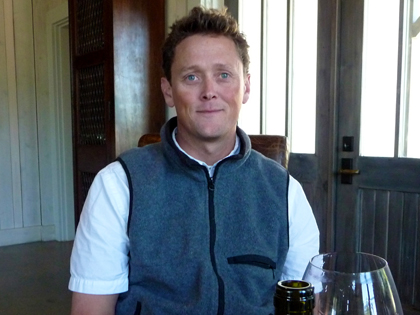
Saul had his conversion on the road to Damascus. Wells Guthrie had his conversion on the road home from Burgundy.
The lanky, California maker of pinot noir, chardonnay, and syrah told me at his Sonoma winery that he had his conversion in 2005, after returning from a trip to Burgundy and the Rhone. He tasted the pinot noirs and syrahs he had been making since starting his own label, Copain Wines, in 1999. The wines were made in a big, full-bodied style and had received high scores, including some 95s from Robert Parker. (Wells’ resumé includes working a year at Turley, as well as briefly at Marcassin, and two years with Michel Chapoutier.)
“A light went on,” he says Read more…
Txakoli, albarino, Manzanilla and more! A Spanish tasting
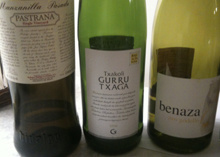 A group of friends that know each other through their sons’ school has a tasting every so often. I’ve been fortunate enough to lead the smart and fun group in about ten tastings over the past couple of years. Our most recent tasting explored the exciting category of Spain beyond the fruit bomb, focusing on indigenous grapes, values, and/or off-the-beaten-path regions. Read more…
A group of friends that know each other through their sons’ school has a tasting every so often. I’ve been fortunate enough to lead the smart and fun group in about ten tastings over the past couple of years. Our most recent tasting explored the exciting category of Spain beyond the fruit bomb, focusing on indigenous grapes, values, and/or off-the-beaten-path regions. Read more…



